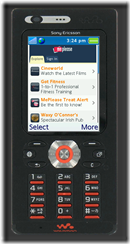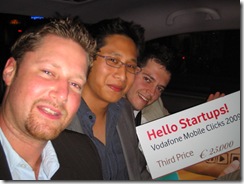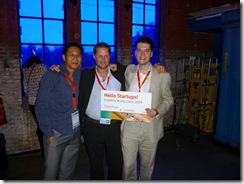It has struck me that the mobile industry, despite being enormous, has a lot to learn still and some growing up to do when it comes to diversifying their business, increasing revenues and creating a sustainable ecosystem.
Mobile technology is central to our world these days and is a remote control for life. It’s our access to our friends and family. It’s the route to information at the click of a button. It’s how we find our way around the city streets. It’s how we communicate and it’s how we consume media of all kinds – interactive or not.
My background is retail (although not grocery, which I know has some unique characteristics) so I’m slightly biased here, but I think we, in the mobile world, have a lot to learn about from other sectors like retail and FMCG when it comes to product development, wholesaling goods, customer service, merchandising and display, marketing and lots more besides. It is said that Britain is a nation of shopkeepers yet we don’t seem to have applied that thinking enough in the world of mobile.

Photo credit: Tom Arthur
Think about a supermarket - And let’s face it, most App stores are essentially supermarkets for apps. Supermarkets stock 1000s of lines – but they are all carefully selected and chosen based on customer insight and buying trends, the products are placed carefully, if not scientifically, on shelves to maximise their potential for sales. Certain products are promoted in a variety of ways – sometimes by the supermarket, but more often than not by the producer, or even if the supermarket does the marketing, it’s paid for by the producer. Next time you go to the supermarket have a look at how things are promoted - 3 for 2 offers, buy tortilla chips and get a certain brand of salsa dip free, recipe cards encouraging you to try certain ingredients, free samples, on-pack promotions – there’s a lot going on and this list isn’t exhaustive. Products and brands are competing for physical space, customer mindshare and ultimately for sales.
Now let’s look at your typical app store. It’s all very democratic and level playing field, sort of. Pretty much anyone can upload their app (subject to rules of decency, and some limited technical, legal or commercial constraints). There’s no particular product selection process to make sure the product is right for the store or more specifically the customer base of that store beyond having the right device (iphone, Android, Series 60 Nokia etc). Prime shelf space are the app charts in specific categories and it’s very limited. And it’s hard to find stuff – mainly because there’s too much there in the first place. (Can you imagine what your local Tesco would look like if everyone who’d ever had a product idea put it up for sale in the store? How much shelf space would you need and how, as a shopper, would you find anything?). There are limited promotions. I haven’t seen any 3 for 2 offers, or on(/in)-app promotions beyond an annoying advert which keeps flashing at you when you’re trying to play a game and covers up a key touchpoint in it (top tip, turn the wifi off and the ad-funded app is suddenly not ad-funded any more).

Photo credit: Peekaboo
Now let’s look at Tesco in more detail (I choose Tesco because it’s our UK No1 supermarket with global reach, takes £1 in every £3 spent in the UK on groceries and it’s making £6,000 profit a minute, not turnover – profit, and that’s up 12.5% on last year. It’s big.)
Tesco has a lot going for it which means it can enter other markets and do very well in them – banking (including offering mortgages by the end of 2010), music (even doing exclusive distribution deals with artists like Faithless), book retailing, being a media owner in its own right…
1. Physical location – there are Tesco shops up and down the country of all shapes and sizes, serving all markets. It is mass market.
2. It has the biggest loyalty card in the UK – The Tesco Clubcard. The company who numbercrunch the clubcard and sales data provide amazing analytics for the supermarket to inform the product buying process – which products do or don’t get picked , which get marketed, data to support marketing initiatives and valuable market research data for third parties.
3. It has an online commerce operation for groceries, fashion and household and the related expertise in e-commerce, logistics, distribution, search engine optimisation, online marketing, email marketing and more.
4. It operates in the financial services sector so has information about customer buying habits outside of Tesco for Tesco Bank customers.
5. It has magazines, posters, online advertising – all revenue (and ultimately profit) generating.
6. It has a mobile network which is growing fast. And it has all the associated data that goes with that – call and SMS patterns, mobile data usage – all linked to the clubcard and transaction data.
7. It now has mobile apps – and a growing suite of them. And an ethos that “simpler is better”. You can read more about Tesco’s foray into the world of mobile apps at Nick Lansley’s TechForTesco blog.
8. They know how to negotiate deals and how to work with suppliers to drive down the cost of production to improve their profit margins (this is not always good for the producer, but Tesco has this down to a fine art.
9. They’re focused on customers - customer service and getting the in-store experience right (not perfect, but good enough enough of the time that customers are satisfied) is key. They spend a fortune on staff training which includes customer service. And they have staff on hand to answer your queries and give you a smile (mostly) when you shop with them. I don’t know if this is replicated with the online shopping experience or not as I don’t use Tesco for online shopping.
10. It has really deep pockets. Like really deep. Did I mention they’ve been making £6,000 a minute PROFIT?
So what if Tesco were to really take on the mobile world? What might it look like?
Well, the app store would be more focussed and better organised (simpler is better). The apps perhaps could be bought on a wholesale basis rather than a revenue share. That way, rather than piling it high and selling it cheap, a proper selection process could happen and the app store’s shelf space would be limited (just like it is in real life). You’d earn loyalty points with each sale. Points can be used against rewards or money off any of your shopping at Tesco (whether that’s Tesco Mobile or your grocery shopping). Not only that, but the developers might be able to negotiate a better revenue share deal.
And what about if we looked beyond the app store. How about if Tesco provided suppliers (be that FMCG, mobile apps, clothing, whatever) with a full-service marketing option. Customer insight (based on transaction data plus mobile data cross matched with qualitative stuff and all opt-in) with multiple routes to market via mobile, magazine, posters (digital and physical posters), product placement, shelf offers (digital and physical), location-based (based on your usual local store and/or your actual physical location). Add in cross-marketing opportunities between different media and apps across the Tesco portfolio – now that would be a very powerful offering.
And what about if Tesco were to take on some web 2.0 and mobile 2.0 principles and built-in customer collaboration, accessibility to the tools which isn’t just based on how much money you have, and working with producers and suppliers to help them improve the supply chain process to cut costs and improve margins?
Could that happen? Would that happen? Would we want it to happen? (I can see there are a whole bunch of data privacy issues looming with it – will data monopolies be banned like company monopolies are?)
Are the network operators still making so much more money that they make Tesco look like chicken feed? Is Tesco the David to the MNO’s Goliath?
Comments, thoughts?
Bango releases it’s latest free Whitepaper on mobile analytics with interviews and comments from industry experts. It includes key factors driving successful mobile campaigns, and offer hints and tips for brands seeking to replicate this success. The report also highlights the common mistakes that result in lower than expected results, and examines the dangers of using PC web analytics to gauge the success of mobile campaigns. It also talks about the importance of feature phones and how the various smartphone platforms play out.










